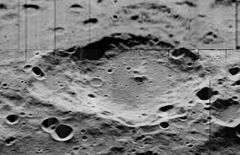Joule (crater)
|
Mosaic of oblique Lunar Orbiter 5 images, facing west | |
| Coordinates | 27°18′N 144°12′W / 27.3°N 144.2°WCoordinates: 27°18′N 144°12′W / 27.3°N 144.2°W |
|---|---|
| Diameter | 96 km |
| Depth | Unknown |
| Colongitude | 145° at sunrise |
| Eponym | James Prescott Joule |
Joule is a lunar impact crater that lies on the far side of the Moon. It is located to the north-northeast of the walled plain Mach. To the northwest of Joule is the crater Blazhko.
This is a worn and eroded crater formation. A pair of smaller craters lies along the northeastern rim, and a crater is intruding into the northwest rim. To the south is an outward projection that has the appearance of a crater partly overlain by Joule. The remainder of the rim and inner wall is somewhat irregular. The interior floor is more level than the terrain surrounding the crater, but is marked by some small craterlets. At the midpoint of the interior floor is a central peak.
Joule T, located less than a crater diameter to the west of Joule, lies at the center of a ray system. These rays primarily project to the south of the crater, with the most prominent ray crossing the crater Harvey to the south. Only faint traces of this ray system actually cross into Joule, and are generally restricted to the western rim, inner sides and floor.
Satellite craters
By convention these features are identified on lunar maps by placing the letter on the side of the crater midpoint that is closest to Joule.
| Joule | Latitude | Longitude | Diameter |
|---|---|---|---|
| K | 25.8° N | 141.9° W | 16 km |
| L | 26.1° N | 144.1° W | 69 km |
| T | 27.7° N | 148.2° W | 37 km |
References
- Andersson, L. E.; Whitaker, E. A. (1982). NASA Catalogue of Lunar Nomenclature. NASA RP-1097.
- Blue, Jennifer (July 25, 2007). "Gazetteer of Planetary Nomenclature". USGS. Retrieved 2007-08-05.
- Bussey, B.; Spudis, P. (2004). The Clementine Atlas of the Moon. New York: Cambridge University Press. ISBN 978-0-521-81528-4.
- Cocks, Elijah E.; Cocks, Josiah C. (1995). Who's Who on the Moon: A Biographical Dictionary of Lunar Nomenclature. Tudor Publishers. ISBN 978-0-936389-27-1.
- McDowell, Jonathan (July 15, 2007). "Lunar Nomenclature". Jonathan's Space Report. Retrieved 2007-10-24.
- Menzel, D. H.; Minnaert, M.; Levin, B.; Dollfus, A.; Bell, B. (1971). "Report on Lunar Nomenclature by the Working Group of Commission 17 of the IAU". Space Science Reviews. 12 (2): 136–186. Bibcode:1971SSRv...12..136M. doi:10.1007/BF00171763.
- Moore, Patrick (2001). On the Moon. Sterling Publishing Co. ISBN 978-0-304-35469-6.
- Price, Fred W. (1988). The Moon Observer's Handbook. Cambridge University Press. ISBN 978-0-521-33500-3.
- Rükl, Antonín (1990). Atlas of the Moon. Kalmbach Books. ISBN 978-0-913135-17-4.
- Webb, Rev. T. W. (1962). Celestial Objects for Common Telescopes (6th revised ed.). Dover. ISBN 978-0-486-20917-3.
- Whitaker, Ewen A. (1999). Mapping and Naming the Moon. Cambridge University Press. ISBN 978-0-521-62248-6.
- Wlasuk, Peter T. (2000). Observing the Moon. Springer. ISBN 978-1-85233-193-1.
